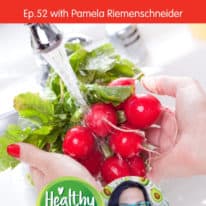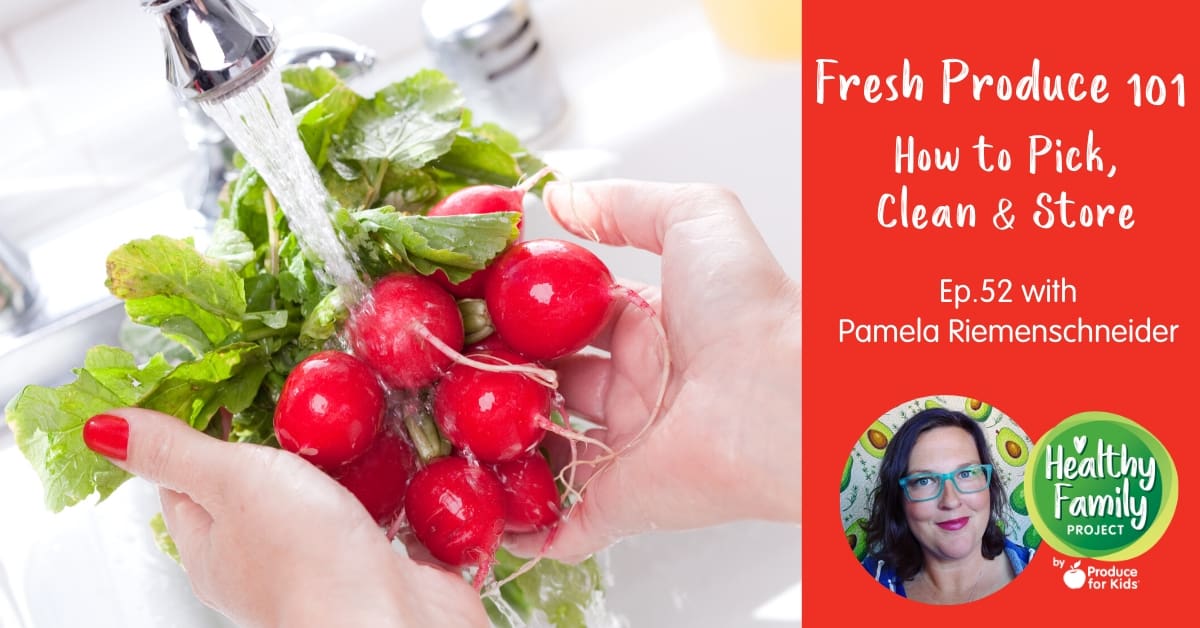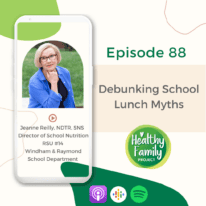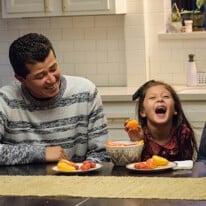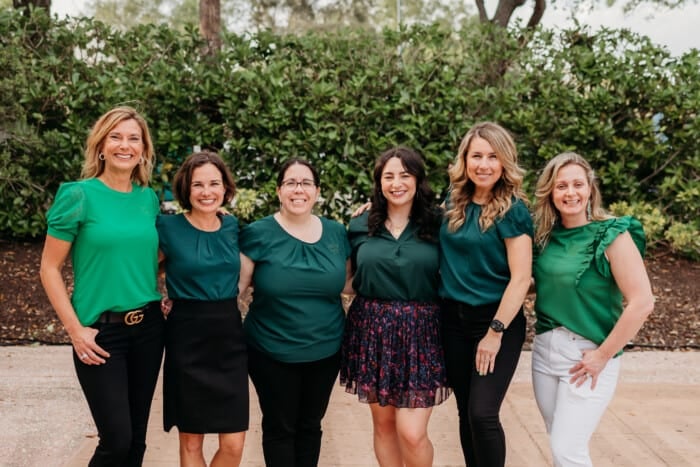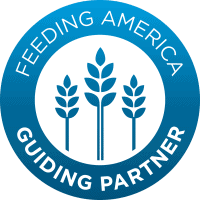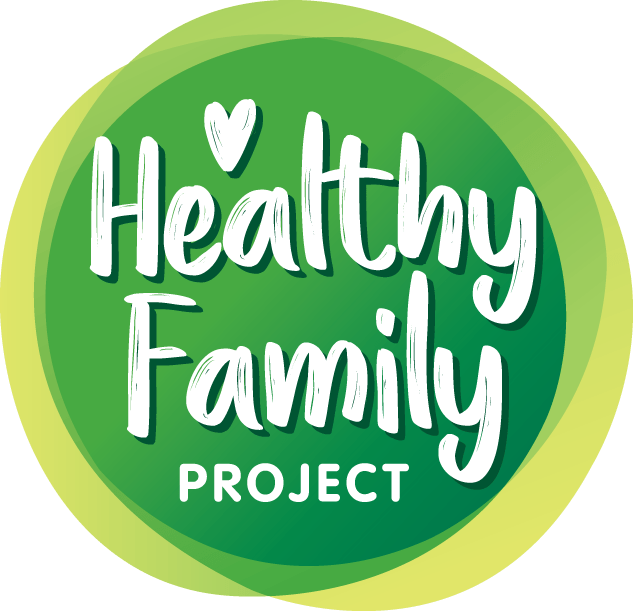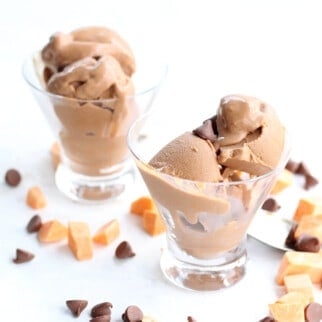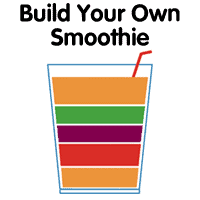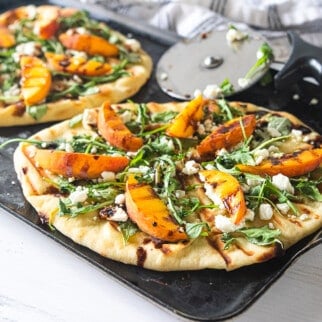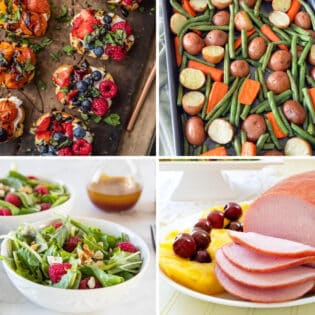Episode 52: Fresh Produce 101: How to Pick, Clean & Store
In this episode of the Healthy Family Project Podcast, we talk to Pamela Riemenschneider about fruit and vegetable hacks and must-know tips to save money and keep your produce fresh for weeks.
Pamela shares her infinite produce knowledge to help us store fruits and veggies properly, ideas for using up foods before they go bad, and an avocado hack that will change your life!
Pamela is a mom of two boys and the retail editor for Produce Blue Book Services. She grew up in the world of fresh produce and has been part of the fresh produce industry for more than 10 years.
Healthy Bites Featuring Eat Smart
Today, we’re snacking on Eat Smart’s Sweet Kale Chopped Salad Kit! Sweet Kale is the superhero of superfood salads. Kale, green cabbage, broccoli, Brussels sprouts, chicory, roasted pumpkin seeds and dried cranberries – all tossed in a classic poppyseed dressing.
Seven superfoods never tasted so good! Enjoy on its own or pair with your protein of choice for a delicious and filling meal.
Listener Survey!
Thank you so much for supporting the Healthy Family Project Podcast! We’d love it if you could take 5 minutes to let us know how we can bring you the best possible content for future episodes. Take the survey here.
Healthy Recipes & Tips in Your Inbox
Sign up for the Healthy Family Project e-newsletter to receive healthy recipe inspiration, our latest blog posts and more directly to your inbox each week.
Healthy Family Project Facebook Group
Join our Healthy Family Project Facebook group! This group will serve as a safe space for parents and caregivers to talk all about raising a healthy family – from dealing with a picky eater and tips to get more fruits and veggies onto plates to exercising as a family and mental health. We welcome all of you to join in!
Want to skip straight to a hot topic? See time stamps below. But of course, we recommend listening all the way through!
- 4:27 Welcome back, Pamela!
- 5:33 Is our food safe?
- 6:44 What’s the safest way to clean our food?
- 9:20 Tips to keep fruits and veggies fresh for longer
- 20:38 Healthy Bite from Eat Smart
- 22:42 How to cut back on food waste? Eat now versus eat later veggies
- 31:52 Bagged versus packaged produce: which one is safer to buy?
- 38:51 What does a healthy family mean to you?
Relevant Links
- Subscribe to Produce with Pamela on Youtube
- 7 Tips to Reduce Food Waste and Save Money
- 8 Fruits & Veggies You Can Regrow from Scraps
- Long-Lasting Fruits & Vegetables for a Well-Stocked Kitchen
- Resources to Survive Quarantine with Your Family
- Cooking Substitutions: Easy Swaps for Common Ingredients
Other Podcast Episodes to Check Out:
- Episode 18: How Families Can Reduce Food Waste
- Episode 50: Managing Kids at Home During Coronavirus
- Episode 36: Dietitian-Approved Healthy Grocery Shopping Tips
Healthy Family Project Podcast
Conversations covering hot topics in the world of health, food and family with a dose of fun. Helping families ease their way into a new fresh and healthy world.
Be on the lookout for new bi-weekly episodes and don’t forget to subscribe on Apple Podcasts, Google Podcasts, Spotify or your favorite podcasting site. If you like an episode, make sure to leave a rating and comment.
If you are interested in being a guest on the Healthy Family Project podcast, contact amanda@healthyfamilyproject.com with your topic idea for consideration.
Transcript for Episode 52
This transcript was produced by Otter.Ai. Please forgive any misspellings and grammatical errors.
00:09
Welcome to the healthy family project by produce for kids, covering the hot topics in the world of health,
food and family with a dose of fun. Hi, everyone, and welcome back to the healthy family project. I’m your
host, Amanda, just a few things before we jump into today’s topic, remember to check in over at produce
for kids.com for new recipes being added to the site regularly. We also have our healthy family Project
Facebook group, where we continue the conversations from the podcast. And also, uh, you know, other
conversations are popping up in there all the time, but definitely a good spot to interact with other parents
and guardians, and, you know, just share good information back and forth. So the link to that group is in
the show notes, simply request to join and we’ll approve you and would love to have you over there. My
daughters and I have been doing a regular Facebook Live on the produce for kids Facebook page every
Friday at 3:30pm. To kick off the weekend, bring some laughs and conversation to people. My daughter,
Charlie and I are on camera making recipes and talking about, you know, just relevant things going on
ways you can give back in your community. And Mia, my older daughter is our producer. So it’s been a
lot of fun. And we’re doing that every Friday 3:30pm And if you miss it, we are keeping it up over on the
produce for kids Facebook page. So you can always rewatch and snag the recipe there. They’re all
recipes that are on our produce for kids.com site as well. So you can kind of watch us step by step and
then go over there and make it yourself. Also, we have a new blog post on regrowing kitchen scraps
which has been a hit, I guess kitchen scraps meaning those fruits and veggies that you might otherwise
toss out. So here in our house, we’ve been regrowing romaine lettuce, celery, and green onions, which
has been fun to watch. Those produce items kind of just regrow themselves just amazing. Today’s topic.
Alright, let’s jump in. So there have been so many questions around buying fresh produce at this time,
and I felt like it only made sense to have my friend Pamela Riemenschneider. Join us to debunk some of
the false information being shared and give us a sense of confidence as we head back to the grocery
store. Pamela joined us on episode 18 talking about how families can reduce food waste at home, which
we’ll link up to in our show notes. Definitely a complementary topic to today’s topic. I highly recommend a
listen to that episode. A little about Pamela she is the mom of two boys and the retail editor for produce
Blue Blue Book services. She’s been part of the fresh produce industry for more than 10 years with with
lots of insider tips. Truly she is a sounding board when it comes to all things produce. But this topic
definitely over the past couple months. As we’ve seen changes in the way we shop and the way we buy
fresh and the questions we have around fresh. She has done her due diligence, researching and being a
part of that conversation to ensure that our families are still able to buy fresh produce and with
confidence. Let’s get started with Pamela. Welcome back. Pamela it’s always great to talk with you and
share your produce industry insider knowledge with our listeners. That was a tongue twister. So many of
us are starting to head back to the grocery store. I know it’s strange times. And I’ve seen you’ve been
sharing so much about food safety and fresh produce in particular during this time as well. You know, as
ways families can still enjoy fresh produce while limiting our trips to the grocery store and staying safe.
So I’m really excited to dive in and dispel the rumors. There are some some different, you know, some
different information being shared. So I’d like to set the record straight. But before we jump in, can you
give our listeners a little bit of background about yourself in case they haven’t listened to your previous
episode?
04:27
Thanks so much, Amanda. I’m so happy to be here again. I love sharing my produce insider tips that I’ve
gathered. I’ve been in trade media for the fresh produce industry for almost 15 years. And that means I
cover the business of fresh produce. But I also have a YouTube channels called produce with Pamela
where I share all of these geeky inside knowledge that I’ve learned from all facets of the party supply
chain people often think of just to growers, but I you know, talk with researchers and see developers and
marketers and people who handle the produce before it even gets to the grocery store. And then of
course retailers, which most consumers called grocers, or their supermarkets.
05:11
Great. So let’s start with the number one question we’ve been getting. Is our food safe? So do we need
to wash just just fresh produce or also food packaging? And of course, the trick question, how do we
clean it? No bleach, right? No, no bleach. So what’s the safest way to clean our produce lots of
questions. They’re all in one.
05:33
I think most people are familiar with what we call the cycle of news, right? It’s where one topic gets really
hot. Everyone talks about it, and then it’s almost immediately forgotten. And where the topic originated, is
forgotten. Or if it was even a fact in the first place, it kind of sticks in your mind. And the one thing that
I’ve been chasing from this cycle of news ever since about the second week of this crisis, is the safety of
fruits and vegetables. There was a widespread video on YouTube that was made by a family physician, a
guy in his scrubs and I feel like I should mention he has no background in virology, which is the study of
viruses and how they spread. This guy recommended that you should put your groceries in a three day
quarantine in your garage, and wash your fruits and vegetables with soap and wipe down the bags of
salad with disinfectant. The scientific community has widely rejected this video. The fear is completely
unfounded your produce is safe, there’s no evidence that the virus that causes COVID 19 can be
transmitted by eating it or that anyone can get it by touching fruits and vegetables or packaging or
takeout for that matter. The other important piece of information here is that you should never wash your
fruits and vegetables with a substance isn’t created for that purpose. Dish soap and bleach are definite
no no’s I know a lot of people believe that vinegar or baking soda or salt water is a good solution for
cleaning fresh fruits and vegetables, or even one of those commercially available produce soaks but
there’s no scientific evidence that those are any better than 10 seconds under cool running water. And I
know it doesn’t sound like much just 10 seconds under cool running water but think about it think really
hard that you actually wash your produce for 10 seconds we’ve all come up with these fun songs to
remind ourselves to wash our hands with it sing Happy Birthday twice or, or any other combination of a
22nd song. Do people have a jingle for washing their apples for 10 whole seconds?
07:33
I really mean it. We got to find one
07:37
right there needs to be a fruit or vegetable song I hear that Harry style says something about watermelon
sugar I don’t know about
07:44
Okay, that’s it. That’s gonna be the song.
07:49
This time yourself next time. I think a lot of people will be shocked at how long they’re actually watching
their fruits and vegetables. And also people don’t think about washing things like onions or watermelons.
Big big things like watermelon, some some of these come typically a little bit dirty. They’ve been on the
ground. Potatoes, watermelons, carrots, they could use a fruit or vegetable brush to help dislodge any
dirt. Because we have a handy purse for kids one that I picked up from you guys a while back. It’s great
for washing carrots because I don’t like to kill carrots. So those are some tips for watching fruits and
vegetables. Really, scientifically I promise 10 seconds under cool running water is all you need.
08:32
Good simple, I like it. Well we’ll have our bullets in the show notes and so that’s that’ll be what we pull
from there. No need for stress. 10 seconds under cool water we got it. Alright, so when shelter in place
measures were first announced we published a post here at produce for kids highlighting 16 Longer
Lasting fresh fruits or fresh produce items like potatoes, apples and onions. And this post has been really
popular. We know families are grabbing these items at the store but there are plenty of other fresh
produce items that will last as long if you store them properly. So what are your tips for storing items
especially fruit which is you know always hot with the kids so families can enjoy them a little longer.
09:20
I think people think that fresh produce goes bad quicker than it really does. I have a bunch of apples that
I bought in January that are still in my crisper drawer I have a second fridge out in my garage. And I have
gone back to that to check on these apples because they were Cosmic Crisp, which was a fancy new
variety launched this winter and I wanted to see how long they’re lasting so they’re kind of a test subject
in there. Okay, so good. From January, no special treatment and I even left them in the produce bags
from the store. So store properly. Most fruits and vegetables will surprise you they will last long potatoes
sweet potatoes, onions, apples. All of these guys are rock stars and that shelf life department for a lot of
consumers. It’s a well deserved reputation, provided you’re storing them correctly. I’ve had potatoes go
bad and it’s not a smell I would wish on anyone. Yes, I hear Yeah, yeah. Don’t leave them in a sealed
plastic bag where it’s warm. Potatoes like it cool, dry. Especially they like dark. Don’t leave them where
sunlight can get to them because they will turn green. So don’t think that your potatoes are going to live
forever, you do need to store them properly. But then there are other items like that, that people think are
more perishable than they are. Pears for example, they get a really bad rap when it comes to shelf life.
But I tend to buy mine and keep them for at least a week, sometimes more. You can grill or poach them
or put them in a salad when they’re still a little crunchy. And once they’re ripe and soft, and remember
pears ripen from the inside out. That was explained to me by a scientist once where he everyone
squeezes their pears and they’re trying to figure out when they’re ripe. If it’s squishy on the outside, it’s
already to ripen the insect. So you just push gently down the neck to see if they’re right. When you feel
that gentle give up there on the spider stem. That’s when they’re right and you can put them in the fridge.
That’s a great tip. I’m going to expand on a little bit later. Once it’s where I put it in the fridge. We’ll talk
about that in a minute. Mangoes two are a shelf life superstar people don’t realize this and mangoes are
also very inexpensive especially this time of year. I love to buy the honey ones which are the yellow ones
and let them ripen on my counter. So when you buy them at the store, get them when the skin is nice
and smooth. You don’t see any dark pits. Scars are fine little discoloration as far as a little bit of green or
maybe some some marks on them. That’s okay, but you don’t want to see any dark pits. Okay, so when
the skin is smooth, they tend to have a firm flesh and are less sweet. But when the skin starts to wrinkle,
and it gets very thin, people think that that’s gone bad. And it’s actually that’s when the ultra sweet, really
delicious mango starts. That’s when they’re really getting Ultra sweet and they’re perfect to eat. And I
think it’s really important to have a good idea of when the fruit should be stored cold, or fruits or
vegetables should be stored cold and what’s best at room temperature. Those are the two tips there. The
University of California Davis has a great factsheet for that and we’ll link to that in the show notes. Most
vegetables, this is just kind of a key guide prefer the refrigerator. They store quite well in there are some
tricks like trimming an artichoke stem, putting them in water like a flower. A lot of people don’t realize an
artichoke is a flower. I explore that in person families show you exactly what our artichoke looks like
when it is bloomed. It’s beautiful. That helps rehydrate it like if you just take it and cut about a dime with
off of the stem and then put it in a cup of water and store them standing up in cups of water.
13:11
Oh wow. I knew I knew this.
13:13
Nothing wonderful artichoke growers. So you do that, especially the night before you cook them. So if
you go buy at the store, bring it home and then put it in a cup of water in your fridge. Then the next day
it’ll be rehydrated and it helps make the flesh when you cook it to be nice and plump and nutty and
delicious. Instead of dried out sometimes artichokes can take tastes dried out when you cook them.
Especially roasting in that that’s a really cool tip that I learned from the grower. That’s great. And then
let’s see what else works well in the fridge. Mushrooms are best stored in a cloth or paper bag I actually
got a cloth bag that a mushroom grower gave me once it’s like one of those cloth bags that you take to
the store like the hipster bag or something like that. You could even wrap your mushrooms in a tea towel
if you don’t have a paper bag. Not many people have paper bags at home anymore unless you had a
craft project where you needed some brown paper bags to make puppets or something like that. So if
you don’t have one, you don’t really need one you can actually just wrap your mushrooms up in a tea
towel and maybe throw it in a bowl so it doesn’t get contaminated by anything else in the fridge and that
will keep them fresher and as mushrooms start to their gills open and they start to maybe get a little bit
brown. That’s when they actually taste better. So you don’t have to eat them when they’re super closed
up. As long as they aren’t slimy mushrooms continue to get better and better flavor richer umami flavor.
The longer that you keep them and then they’ll start to dry out and dried mushrooms actually can be
ground into umami powder like kumbaya traitors yet
14:58
another I every time I talk to you. I learned so much. So I felt like my kids are totally into like the science
of food right now. So I think there’s some good fun things here. We can do it all on the science side for
them.
15:13
Yeah, well, moving on to our lettuces and salads, those are things that need consistent refrigeration, you
have to be very strict about your refrigeration. With those, every degree out of optimal temperature for
refrigeration for a bag of salad takes a day off of the shelf life. Even if it says Best Buy on a certain date,
that’s not an actual scientific stop date on a bag of salad, that’s actually the date that the manufacturer
says the condition should be the best. After that date, sometimes you can get a day or two after that
date. Sometimes you can actually get a day or two or three before that date when the salad has actually
gone bad. And that’s because it wasn’t kept in temperature somewhere in the shelf life. So a trick for
buying bagged salad to try to make sure that you have it stay fresh as long as possible at home is to you
know, your grocery may not like us reaching the back. The one from the back the one that’s been kept
cold as the long right.
16:13
I know I do this, I I look around like I know someone’s gonna say hey, what are you doing?
16:23
Do that and then it when you know we’re in warmer areas already. And keep one of those insulating bags
in your car if you have more than five or 10 minutes home from the grocery store. Keep your salads
insulated so that they stay cool in the car. Don’t make too many stops after you’ve picked up salad. And
then straight into the fridge with those bagged salads that’s tender leafy greens like fancy field greens or
something that’s already chopped. The other letters that is the one that you buy for later in the week is
romaine lettuce, romaine lettuce can, especially the hearts of Romaine that are bought in a package of
three. I have had those last four weeks in my fridge as long as they’re trimmed as long as they’re, you
know, sealed up in that in that package, they tend to last forever. So get the tender leafy greens eat
those early in the week, eat the romaine later in the week. And the biggest one that a lot of people don’t
realize is that berry packaging is designed to maintain shelf life. Don’t take your berries out when you
wash them when you get home. That’s a that’s that’s one of the advice that I see that is one of the the old
Whack a Mole game that keep whacking it no no don’t do that. Very packaging, they’ve developed it with
just the right vents, they pack them they’ve done a lot of testing to see what maintains very shelf life the
best and it really is that clamshell that you buy them in. So when you buy them at the store, buy the from
the refrigerated case, even if there is a dry table, if there’s a dry table with berries that smell amazing. If
you’re not going to eat them that day, walk right on by and see if there’s some in the refrigerated case.
And by the from the refrigerated case, berries also have that for every day, our out of shelf life, you lose a
day of our out. For every hour out of refrigeration, you lose a day of shelf life. It’s very similar to salads,
you want to buy your berries in a refrigerated, take them home, leave them in the package and put them
in refrigeration immediately. And you warm them up before you eat them. Because the smell really helps
enhance the flavor of berries. Also, when people talk about putting them in a bowl of vinegar water to
soak to maintain the shelf life. No. Those berries immediately start to break down when you get them
wet. So you don’t want to wash them until right before you eat them.
18:52
So So washing them just with the cold water is fine. You don’t vinegar them,
18:57
okay, washing them with just cold water is fine. You don’t need vinegar. And you know a lot of folks like to
do the vinegar soak with berries because they believe it like gets the mold off for water or whatever.
Because if you’ve, you know, berries are one of those things that can mold quickly. That’s something that
was already on there. And some somewhere in the supply chain and just take it back to the store if you
can and get a new container of berries, the store will happily replace those if you do end up getting a
moldy berry because that’s going to happen very quickly. It’s not something that’s going to maintain the
shelf life by putting vinegar on them to keep it from molding. It’s going to mold it’s gonna mold quickly.
And there’s nothing you can do to prevent that.
19:41
And now it’s a most times our berries are great, but you know there’s this few times that it’s like Darren
one little mold piece of mold on that one little barrier on the bottom. Yeah, the one on
19:55
the bottom. Yeah, you know if you do find like a blueberry with a little tiny pack a mold on it. You know
what, toss that one wrench the rest of them and freeze them and throw them in a smoothie. Just that one
Berry is no big deal. Strawberries are a little more challenging when that one berry gets the little bit of a
fuzzy mold on those. Those are the ones I tend not to eat if that happens but if it’s a blueberry or
raspberry, I just pick the one out of there.
20:22
Right? Yeah, I know this. That trick I got that one down.
20:27
I got that one from a retailer because I’ve seen them do it on the display before where they have the
purchase cord go through and pop out of a moldy buried deep ongoing
20:39
now we’re taking a break for a healthy bite with our friends from Eat Smart Grace should be here any
minute with something delicious, I’m sure.
20:45
Hi, great to be here today. Today have a tasty sweet kale salad from Eat Smart. The salad has been a
fan favorite for some time.
20:53
I cannot wait to dig in. I love the variety of Eat Smart bagged salads out there right now and I’m hungry
so handed over,
20:59
please Here you go. So while you’re enjoying the salad I have to save the sweet kale is the superhero of
superfood salads. Kale, green cabbage, you hear the crunchy Oh Amanda, French broccoli, Brussels
sprouts, chicory, roasted pumpkin seeds and dried cranberries all toss in a classic poppy seed dressing.
What do you think Amanda?
21:20
This is delicious. I’m a fan. I love the dressing and I see lots of sweet kale salads in my future. So also,
this is so easy to mix up for a quick weeknight dinner. Or if you want to add like a protein to make a full
meal.
21:33
Yes, and kids can easily mix us up to great way to get them involved in meal prep.
21:38
When great tastes and my kids can make it for
21:41
me. Exactly. If you’re looking for creative ways to use bagged salads, we will link up to a blog post in the
show notes. You can also enter to win a month’s worth of free salads from Eat Smart during the share
your salad contest. Remember, it’s a hashtag share your salad. More info is included in that blog post to
locate a grocery store where you can find Eat Smart, bagged salads, go to eat smart dotnet or go to the
show notes to a direct link.
22:04
So I know you have a strategy for shopping I’ve been following along in your shopping endeavors over
the past couple of months as we navigate all of this craziness going on. So you have a strategy for
shopping to make the most out of your produce and avoid waste as many of us start to head back into
the grocery store but maybe don’t want to be going multiple times a week. I think it’s important to shop for
that no waste goals. So what is your current strategy tips for those looking to maximize the life of their
produce and and kind of cut back on on waste.
22:42
So I’ve got a couple of things that I do. I try to go once a week so I’m buying into stages and I mentioned
this before you buy for the Eat now and then you buy for the eat later. Eat now is leafy themes like
tender, tender things like spinach, kale field greens, bagged salads with kids. It later is lettuces like
romaine hearts last forever if you keep them children dry. A few more eat now vegetables would be
asparagus, artichokes, green beans tend to dry out if you don’t need them right away. pre cut vegetables,
things that have been packaged, take a look at the best by date see how many days you’ve got left. Take
a look at the condition of the bag when you get it home and make sure that it’s not got a lot of moisture in
it. Those things should be eaten right away radishes, anything that you find in the misting case in the
produce department. That’s a good clue for something that needs a little more it’s a little higher
maintenance, they’re divas. They’ve got to be misted to maintain that shelf life to me maintain the
freshness. Think about if you’ve ever bought bunched carrots with the with the leafy things on top right
look amazing in the Mr. And then if you take them home and put them in your fridge the next day they
look terrible. It’s because those leafy tops have sucked all the moisture out of the carrots and they have
to be continually missed it to stay fresh looking you just buy your cares in a bag but they don’t have the
leafy thing this second dry. So anything you see in that Mr. Typically needs more maintenance typically
needs to be eaten quicker. So what one caveat for that though, is that there are a few tricks you can do. I
buy a lot of cilantro. I live in Texas, we eat a lot of salsa, we use a cilantro and just about everything I
know there are haters out there. Nobody in my house is fortunately but for parsley or cilantro or greens
like that I washed them in my salad spinner actually have a little one that’s herb size. And then I either
leave it in the salad spinner in my fridge if I have room in my fridge, I don’t always have room to do that.
Or I will take it and wrap it in a tea towel and put it in a ziptop bag with the air kind of like pushed out that
will keep cilantro or parsley or any of these other leafy herbs fresher for a lot longer a couple more days,
even up to a week. So that’s a trick for some of those mystery items. So those are the things you meal
plan and think I’m going to use these things in my first three or four days. And then can’t there. There are
a few fruits that are sold in ways that you can buy two stages as well think about bananas, you can buy
green bananas and let them ripen by yellow bananas and eat right away some retailers merchandise
them that way. Just take a look at what you’ve got on the display and decide if if there’s two stages of
bananas that you can take home. Avocados are another one, you can buy both rice and green are soft
and green. They’re right. They’re pre ripened before they get to the store. But the ripening process takes
a few days. But here’s my mind blowing amazing trick that if you didn’t learn anything else you learned
from here, even some insiders don’t even know this. I buy avocados, green and hard. This is the Haas
variety. I buy huge bags of them at club stores. And then I let them ripen on my counter. And once they’re
ripe, I put them in my fruit crisper drawer where it’s dry and cool. And they stay ripe for at least another
week. Sometimes two or three. So this means I always have ripe and ready avocados eat all the time.
And it’s amazing. It will change your life if you if you’re just like, boom, do I want some avocado toast?
This is not something I have to plan in advance. I always have avocados it’s like my crisper drawer is the
shrine of perpetual avocados.
26:37
I can I can vouch for this. Because you shared this with me. I don’t know how I can’t time right now is not
good for me to register time is not registering. But a while back. You shared this tip with me. And I’ve
been doing this because we eat a lot of avocados in my house. And I can vouch for it. It’s amazing. I
always have avocados and my my neighbor is always amazed. She’s like, how do you because I buy
avocados. And they’re either not ripe, or they’re bad. And so I was like, Listen, you have to do this trick.
So I’m continuing to share so I can say it does work and it’s been a game changer.
27:18
It’s a game changer. And it’s also like a complete mindset changer because no one would think, Oh, I’m
going to go to the store and stock up on avocados. But you absolutely can. And now we eat so many
more avocados because of this because we have them in so many other usages. It’s not like reading
guacamole four times a week. We’re doing smoothies, I always put an avocado in my smoothie because
I tend to not like bananas in mind because it makes it too sweet. And avocado gives the creaminess that
you want to have when you drink a smoothie. I do avocado salads. It’s it’s such a it’s so much fun. And if
you’ve got kids who don’t want to eat, maybe chemically cooked fish, which is what savich is chemicals
as in lime juice, you can always sear it and make it a little more palatable for some some folks who don’t
maybe are squeamish at the spray aspect of it. But that it’s a game changer. I just have avocados
everywhere.
28:19
I was gonna say with the smoothie. We just I just turned my kids well, my older daughter, she’s into
making smoothies and adding different ingredients that we have around. And just last month, we didn’t
have she likes Greek Greek yogurt, and they said just use an avocado if you’re trying to make it creamier
and she really had a hard time. Like putting that avocado into the blender. She kept looking at me saying
Are you sure this is not going to mess this up? Like I just can’t look at this and put it into my smoothie.
And then she did that. And I can tell you for the past month. She’s like where’s the avocado. Like I have
to have the avocado. It just gives my smoothie the best consistency.
29:05
I am working through some issues with my kids right now because I like to put greens in my smoothie.
And so greens plus Mango Plus berries makes brown or not into brown smoothies. I could it but it tastes
amazing. They’re still like ooh, it’s brown. And like guys, it’s really really good. The other one other thing
that you can use as a smoothie base that a lot of folks don’t realize is if you roast the sweet potato until it
gets all loozy and then use the scoop like a quarter of a cup of sweet potato into a smoothie. It adds
sweetness. It adds that sickness of the people like at US movies, but that would blow her mind too
because if she was squeamish about an avocado she’d be be there’s even purple sweet potatoes that
you can use for that as well. And I used to do it and I just haven’t kept up with them. So I have it and I
was thinking about it the other day, I was like, You know what I really should be using sweet potatoes in
my smoothies, and I just hadn’t done it.
30:07
Alright, I’ll, I’ll let you know. We’ll try that next time.
30:11
The other final tip that I have, for my layered buying is to mid week, take an inventory of what you have
in the fridge. And maybe it’s time to put out a grazing board. Before I go to the store, before I start my
meal planning, I look at what’s in the fridge. And that is grazing board day. That’s when I use up a lot of
the fruits that need to be used. I use up a lot of the vegetables that need to be used and kind of take
stock of where we are in the week. It’s usually maybe not midweek, maybe the last day or two before it’s
time to go to the store and use up those last few things use up the last bell pepper or grapes or
something like that. Use that as a tool to make sure that you’re not wasting anything. And then of course,
you know for me grazing board is actually lazy mom dinner.
31:07
I know I’m with you on that I love a grazing board.
31:12
That but those are my tips. By stages by eat now eat later for both fruits and vegetables. And then take
stock of what you’ve got. And do a grazing board of all the leftovers before you go to the store.
31:28
Good great tips there. Got to remember those for my my grocery run this week. But I think the Eat now
eat later is just a good takeaway to kind of think about as you are picking your produce. So what about
thoughts on buying bagged or packaged rather than loose produce? We’ve had this question on our over
in our Facebook group, do you think one is safer than the other.
31:52
I personally and professionally am not afraid of any produce bagged or loose i by all. I do however wear
a mask where as is recommended, I am required. Depending on where you’re shopping. There’s some
club stores that require masks. And I carry hand sanitizer in my car. Although I’ve heard that when it gets
really hot, you might not want to have it in the car to double check on that one. So I carry hand sanitizer
in my car. Once I use it. Once I’ve left the store, I wash my hands thoroughly when I get home. First thing
after I get home. And then after unloading everything and storing my groceries I watch again, I also don’t
spend a lot of time picking through produce displays. And that’s just to, you know, not be around people.
Basically, I also don’t want to be in that awkward boat of trying to open bags. And you know, everyone’s
trying to figure out how to get this produce bag open without licking your fingers. I have a tip for that. Go
to the wet rack where they have like the salads and the carrots and things like that. And grab some
cilantro or parsley or green onions and get that first bag, just a little wet in the wet rack. So then you put it
in the seat of your cart. So you can have wet fingers for all the other bags that you have in the
department that you need to open. Yeah. And that’s, that’s very helpful in these trying times. But, you
know, packaged versus not packaged versus loose. It’s all safe, it’s all good to eat. It’s just a matter of
how fast you want to get through the department. If you want to pick up a bunch of bagged items.
They’re all there and available. But I wouldn’t consider ones any safer than another.
33:42
Gotcha. I think it’s hard. I mean, for me, especially, you know, to not spend time picking through produce
because of course you don’t want to be touching every piece of produce in the display. But I think it’s
hard. It’s hard for me because I want to I just that’s I don’t want to touch and feel taken home. I feel
34:04
the judgment though if you pick up a watermelon I know the one you want and you could everyone saw
you touch it. It’s like you know take these vaccines on these things. You’ve got to actually take them
when you touch and so it’s it’s tough to get over that mindset but honestly, really, I believe that Produce
Marketing Association had an expert and talk to us that produce blue book about even in the worst case
scenario. If someone sneezed directly on your parsley in the in the wet rack and you took it home and
you ate it. You still wouldn’t get COVID-19 from that because the virus if you ingested your your digestive
system or break it down, it’s a wimpy virus as far as digestive systems go. There are no digestive ways
to transmit it. So even in that worst case scenario, you would not get it. So I think a lot of folks are really
concerned and really worried. But it’s actually, the more caution that you need to have is actually being
around all the other people at the store. And not necessarily the fruits or vegetables that you’re picking
up.
35:17
So that’s interesting. So the judgment is more of the
35:21
Yeah, for me it is, it’s totally a judgment issue. me tell when peach season comes, I’m gonna be a world
of hurt, because I love to sniff peaches.
35:29
I know. So maybe, maybe we’ll have to and I don’t even know if it’s possible. Think about some kind of
infographic to help sight like, look how to look, pick your produce by just looking at it. Like, here’s some
tips,
35:44
cuz I can I can smell through my mask very well. So I don’t I don’t know how many pick peaches, but I’m
it’s not gonna keep me from buying them. So there’s nothing better than a really good peach.
35:54
So I know, well, well, hopefully, you know, we’ll all be taking these precautions and staying safe and and
doing what we need to do. But, you know, my my hope, I guess everyone’s hope is that we’re not going
to have to be be so. So I don’t know how to say it. I don’t want to say not be so safe, because we should
always be safe. But things will will loosen a little bit and we can pick up in touch all the peaches, we want
to touch
36:22
our overabundance of caution. We’ll just turn into an abundance of caution.
36:27
Yeah, yeah, we’ll go we’ll slightly go down there. So I know, kind of off track, but talking about the masks
in the grocery store. i i Last time I was there, I realized how much I actually smile at other people in the
grocery store, which is maybe weird. I just smile at strangers on grocery shopping, while some people
are just like, get me in and get me out. But with my mask, I have found that I smile at people and I’m not
getting a smile back. And it just like threw me for a little bit of a loop this week, like mentally just thinking
about it like, wow, that human interaction is something that is weird that it’s not happening like that
person I wish they could see me like give them a friendly smile, but they can’t. So that was kind of a
bummer. This week, not totally off topic, but
37:19
we need to work, we need to work on our smizing are smiling with our eyes. Everyone has a better smize
37:27
I’m gonna work on that because I was kind of bummed when I left the grocery store. I sat in the car for a
minute and thought, Well, I wish that that wasn’t that way. But I guess it is what it is for the time being.
37:39
I think a lot of the rhetoric that we hear a lot of supermarkets, superheroes and front lines, I feel like we’re
going into battle. When we go into the store. You have to get yourself prepped and get your plan and get
your mask on and, and some of that stuff. It’s an anxiety inducing. So I even feel a little bit worn out when
I get out of the store. So I make sure in by myself a nice treat, like some raspberries, or something like
that. Yeah. I’m rewarding myself for going to the store instead of feeling worn down. And maybe a little. I
don’t know, like, like you mentioned just a little bit bump. Yeah, out of the store. It’s nearly as
38:23
I love me, right. And I know not everybody loves grocery shopping. I happen to love it. It’s like therapy for
me. And so yes, it’s it’s a bummer. But alright, so I don’t think I was doing this yet the last time you were
on the podcast. So I’m pretty sure I wasn’t. But if I was just telling me you have already answered this
question. So there’s no right or wrong answer. It’s just for fun to hear what everyone thinks. What do you
think being in healthy family means?
38:51
Well, right now, I think it means not having a nag at my kids. Just out. I feel like it means having a
balance. And you know, I’m constantly striving to find a better balance as a as a mom, a wife, a
professional, so everyone can feel good about pursuing their goals and have fun and succeed. But
mostly, I feel like my family would be healthy without all the nagging.
39:19
I think my kids, especially at this moment in time as we’re ending the school year would agree with you.
39:28
Cut out to be a homeschool teacher.
39:30
I know that No. Oh. And that was our last episode. I had a friend of mine. Come on. She’s a teacher and
she gave some real, real real talk, which has carried me on through this year which the school year ends
next week, and I’m looking forward to that. There will be a ceremony for me. Oh my goodness. Well,
thanks so much for joining us today. I know you got up early. Both of us to chat It’s hard to find a time.
You know, with being at home and having the kids here and everything else going on. Thank you for
sharing all of your great tips and ideas for families. So before we close out, can you tell people where
they can connect with you?
40:14
Of course, I My YouTube channel is produced with Pamela. And I’m also the retail editor for produce
Blue Book calm.
40:23
Wonderful, and we’ll link up to those in the show notes. Thanks so much, and I will talk to you soon. Talk
soon Amanda. Thanks so much for joining us today. If you like the healthy family project, which I hope
you do, please tell a friend and leave us a rating it will only help our visibility so we can continue to create
a healthier generation. If you want to tweet direct with me. I met Amanda and Kiefer on Twitter, and
Instagram as well. And you can find produce for kids on Facebook, Twitter, Instagram, Pinterest, and
YouTube. Be sure to subscribe Talk soon

